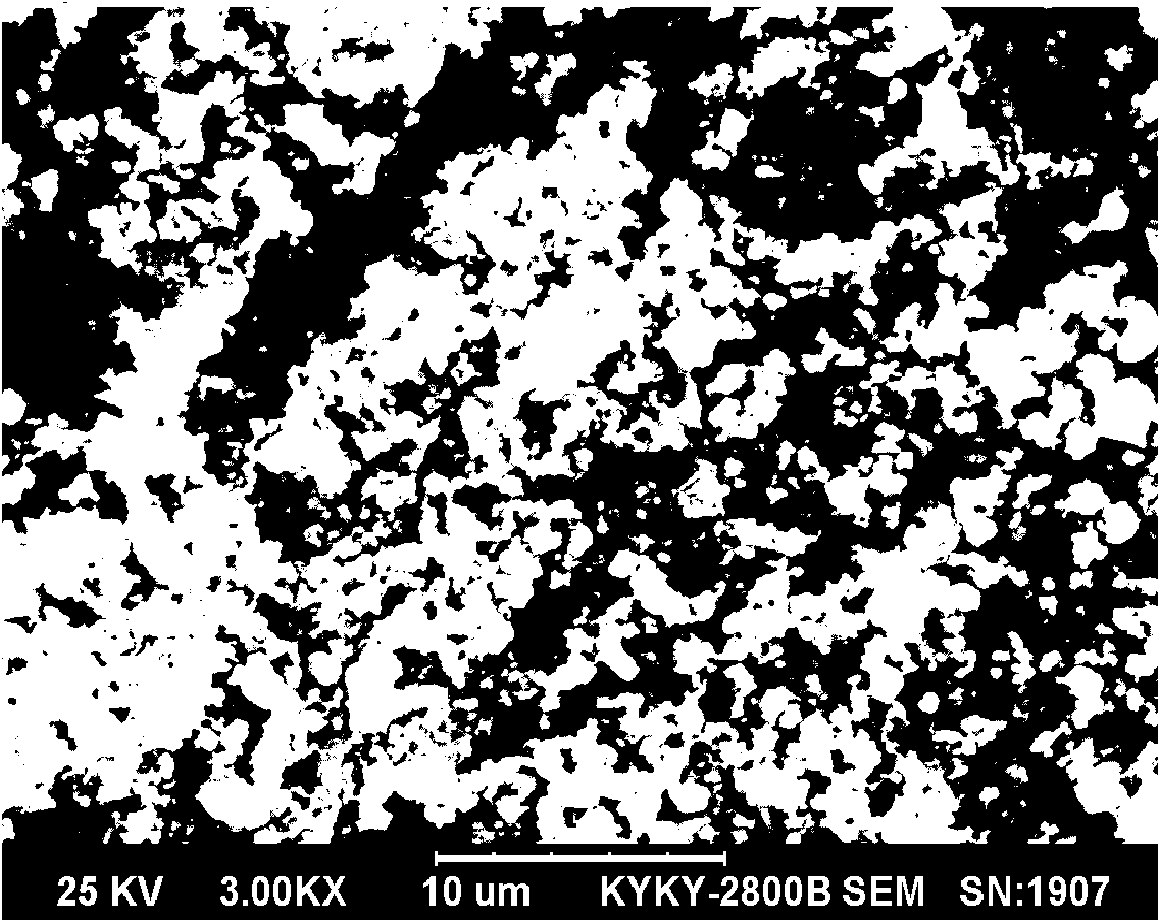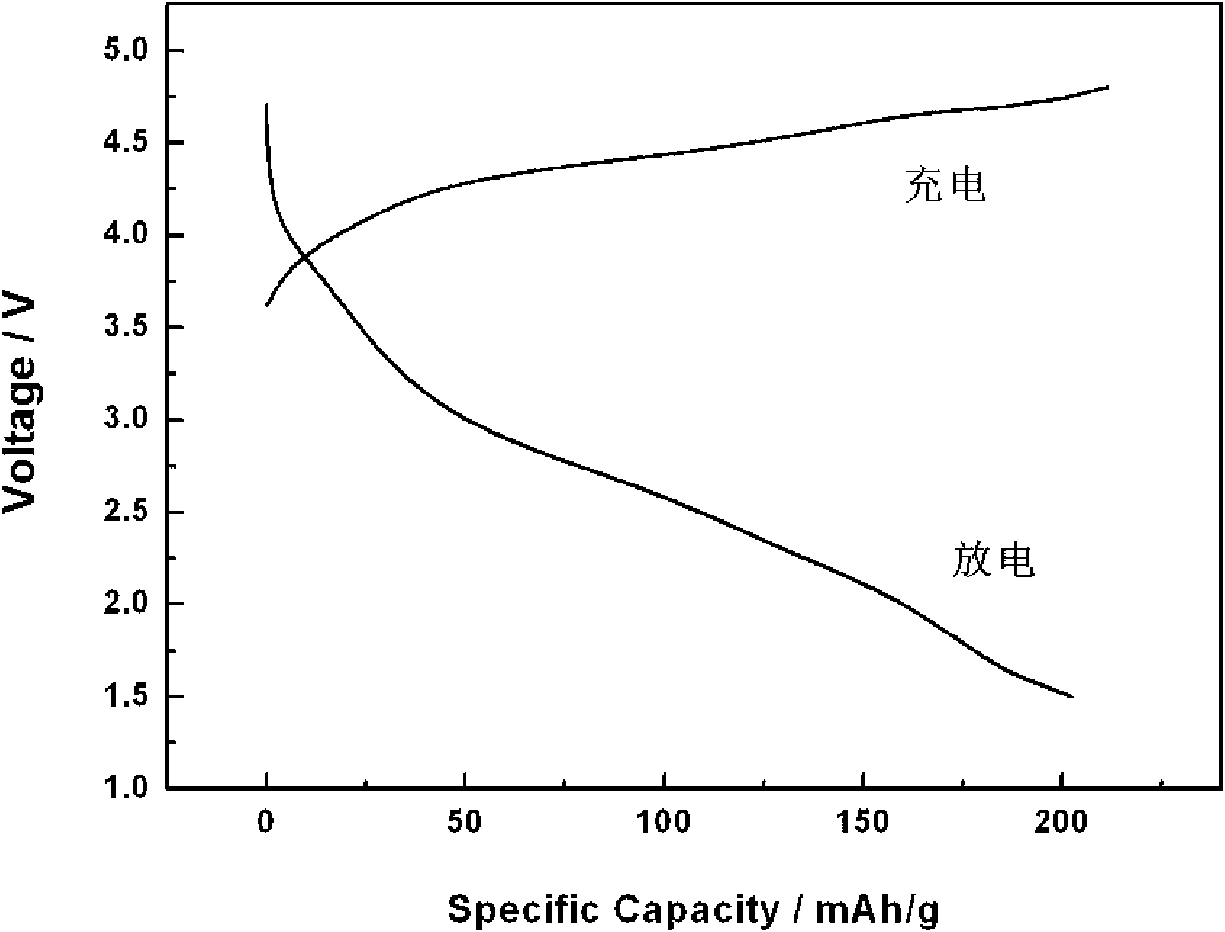Silicate anodal material for lithium ion battery and preparation method thereof
A lithium-ion battery and positive electrode material technology, applied in the field of lithium-ion battery positive electrode materials and its preparation, can solve the problems of low energy density, low voltage platform, poor conductivity, etc., achieve high volume specific capacity, uniform distribution, and improved The effect of conductivity
- Summary
- Abstract
- Description
- Claims
- Application Information
AI Technical Summary
Problems solved by technology
Method used
Image
Examples
Embodiment 1
[0043] Example 1, the tetrabutyl titanate modifier source accounting for 5.0% of the mass of the positive electrode material was dissolved in ethanol at a concentration of 100 g / l, the stirring speed was 50 r / min, and the time was 0.5 h to obtain a tetrabutyl titanate solution. Will Li 2 mn 0.5 Fe 0.5 SiO 4 Slowly put into the modifier source solution, the stirring speed is 300r / min, and the time is 3.0h to obtain the mixture. The mixture was gas-phase-dried and granulated under the condition of 100° C. to obtain a dispersed powder. The dispersed powder is heat-treated in the temperature range of 200°C for 40 hours at a heating rate of 1°C / min, and naturally cooled to below 150°C, during which air is introduced. Fusion treatment after pulverization, rotating speed 500r / min, time 300 minutes, sieve, obtain the silicate cathode material Li 2 mn 0.5 Fe 0.5 SiO 4 / TiO 2 . tested and analyzed as figure 1 As shown, the surface of the positive electrode material is coated ...
Embodiment 2
[0045] Example 2, the tetrabutyl titanate modifier source accounting for 0.1% of the mass of the positive electrode material was dissolved in absolute ethanol, the concentration was 50g / l, the stirring speed was 300r / min, and the time was 2.5h to obtain tetrabutyl titanate source solution. Silicate cathode material active material Li 2 FeSiO 4 Slowly put into the tetrabutyl titanate source solution, the stirring speed is 500r / min, and the time is 5h to obtain the mixture. The mixture was gas-phase-dried and granulated under the condition of 200° C. to obtain a dispersed powder. The dispersed powder was heat-treated at 450°C for 4 hours at a heating rate of 10°C / min, and then naturally cooled to below 150°C, during which air was introduced. Fusion treatment after pulverization, rotating speed 800r / min, time 15 minutes, sieve, obtain the silicate cathode material Li 2 FeSiO 4 / TiO 2 . After testing and analysis, the surface of the positive electrode material is covered wi...
Embodiment 3
[0047] Example 3, the zirconate modifier source accounting for 10% of the mass of the positive electrode material was dissolved in acetone at a concentration of 0.1 g / l, the stirring speed was 50 r / min, and the time was 5.0 h to obtain a tetrabutyl titanate source solution. Silicate cathode material active material Li 2 MnSiO 4 Slowly put into the zirconate source solution, the stirring speed is 50r / min, and the time is 0.5h to obtain the mixture. The mixture was gas-phase-dried and granulated under the condition of 350° C. to obtain a dispersed powder. The dispersed powder was heat-treated at 600°C for 10 hours at a heating rate of 15°C / min, and then naturally cooled to below 150°C, during which time oxygen was introduced. Fusion treatment after pulverization, rotating speed 700r / min, time 150 minutes, sieve, obtain the silicate cathode material Li 2 MnSiO 4 / ZrO 2 . After testing and analysis, the surface of the positive electrode material is covered with a layer of un...
PUM
| Property | Measurement | Unit |
|---|---|---|
| thickness | aaaaa | aaaaa |
| specific surface area | aaaaa | aaaaa |
| thickness | aaaaa | aaaaa |
Abstract
Description
Claims
Application Information
 Login to View More
Login to View More - R&D
- Intellectual Property
- Life Sciences
- Materials
- Tech Scout
- Unparalleled Data Quality
- Higher Quality Content
- 60% Fewer Hallucinations
Browse by: Latest US Patents, China's latest patents, Technical Efficacy Thesaurus, Application Domain, Technology Topic, Popular Technical Reports.
© 2025 PatSnap. All rights reserved.Legal|Privacy policy|Modern Slavery Act Transparency Statement|Sitemap|About US| Contact US: help@patsnap.com



